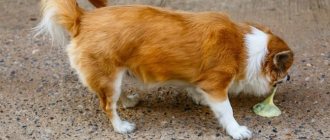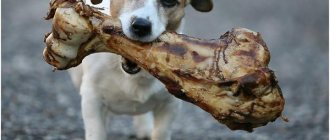Any owner is worried when a dog vomits white foam. However, this symptom can only mean the body’s defensive reaction to the rapid swallowing of food. Air bubbles penetrate the stomach and interact with proteins and mucopolysaccharides of mucus on its walls. As a result, a chemical reaction occurs in the form of the formation of a foamy mass, which is forced out of the stomach by spasms.
When not to worry
The dog feels sick and vomits white foam for various reasons. Some of them are not associated with the development of diseases.
When a foreign object enters the stomach, the secretion of hydrochloric acid increases to digest it. At the same time, the formation of mucus increases to protect the walls of the organ from caustic liquid.
In addition to getting rid of small inedible objects, the body, through regurgitation, gets rid of pieces of missing food. A hungry dog can pick it up on the ground or in a trash can.
After the operation under general anesthesia, the pet is on a starvation diet for more than a day. All this time, mucus forms and accumulates in his intestines. An attack of nausea can cause spasms and vomiting.
During a long trip, your dog may get motion sickness. Kinetosis is often accompanied by weakness, nausea, and vomiting. If there is no food in the animal's stomach, drool will flow from its mouth, mucus that foams when it comes into contact with air.
If the dog vomited white foam once, and after that its health improved, no measures need to be taken. The animal’s body itself coped with the problem, cleared itself of the foreign object or excess mucus. The owner needs to temporarily reduce physical activity and fill a bowl with fresh, cool water.
Pathological vomiting, on the contrary, weakens the dog’s body and accelerates the development of the disease. It leads to dangerous dehydration, which disrupts electrolyte balance. Such convulsions prevent the flow of food into the gastrointestinal tract. The animal is exhausted and cannot resist the pathogen.
What to do: take it to the vet or treat it yourself
To prevent further absorption of toxic substances, after vomiting, the animal should be given activated carbon or other adsorbents to drink. The owner’s actions should depend on the cause of the pathology:
- A small amount of white foam accumulating at the corners of the mouth indicates exhaustion. In this case, the owner can handle it on his own. It is necessary to review your pet's diet and reduce the time between feedings.
- If there are worms in the foam, you should seek help from a veterinarian. The doctor will prescribe anthelmintic drugs depending on the body weight and age of the pet.
- In case of stomatitis or oral trauma, which can lead to the formation of white foam, it is worth examining the animal's mouth. When the mucous membranes of the oral cavity are affected, the dog coughs up blood. It is necessary to remove foreign bodies from the wounds and treat them with a disinfectant solution. With the development of a purulent-inflammatory process, the dog will need antibiotics and special ointments for wound healing. They must be prescribed by a veterinarian.
- During an epileptic seizure, you need to place the dog on its side, slightly holding its head above the floor. When the dog coughs up, you need to tilt his mouth down a little to facilitate the passage of vomit. The animal's body may be shaken by convulsions, so it is necessary to free the space from foreign objects. The dog can get hurt on them. After the attack passes, you need to take the dog to the veterinary clinic, where the pet will be prescribed anticonvulsant drugs.
- If the dog is poisoned, you need to give the dog adsorbents and give enemas. To prevent dehydration, it is recommended to call a veterinarian at home. The specialist will put in a drip with saline solution.
- If you suspect rabies, you must isolate your pet, call a veterinarian, or take it yourself to a clinic for euthanasia.
- Plague is caused by pathogenic microorganisms - Yersinia. To eliminate them, antibiotics and immunostimulants are needed. Treatment should be carried out by a veterinarian. You can give your dog multivitamin complexes on its own.
Read Review of antibiotics for dogs: where and how to give injections
First aid
Before visiting a veterinary clinic, you should monitor your pet’s condition and take pre-medical care:
- Let the dog lick the ice.
- If the condition improves and the vomiting stops, you can give your pet chicken broth. The next day, if the dynamics of recovery are positive, you should give the animal fresh food in liquid form: puree poultry meat in a blender with the addition of herbs and boiled rice. It is allowed to switch to a normal diet for 3-4 days.
- If the condition worsens and the dog refuses to drink or eat, it is necessary to urgently take the pet to the veterinarian. The doctor will prescribe tests, x-rays, ultrasound and cardiogram. Instrumental and laboratory tests will help evaluate the functioning of internal organs, exclude the development of allergies and check for the presence of cancerous tumors.
Drug therapy
If nausea and foamy vomiting occurs in the veterinary clinic, the dog is given injections of sodium chloride intramuscularly or subcutaneously to restore water and electrolyte balance. After this, a diagnosis is carried out and, depending on the data obtained, therapy with the following drugs is prescribed:
- Papaverine or No-shpa to relieve stomach cramps and pain;
- Cerucal, necessary to stabilize the vomiting center in the brain;
- Omez to reduce the acidity of gastric juice;
- Enterosgel, which allows you to speed up the removal of poison from the body.
Treatment with drugs should be carried out by the attending physician. Self-therapy can lead to a deterioration in the animal’s general condition and increases the risk of death. In parallel with taking medications, the veterinarian prescribes a gentle diet. Correcting the diet will help normalize the functioning of the digestive system and reduce the load on organs that are weakened due to intoxication.
Feeding and drinking regime
The pet owner needs to remember what his pet has eaten recently. This information can help determine the cause of vomiting. Before visiting the veterinarian, it is not recommended to feed your pet, so as not to accidentally provoke new discharge of white foam. The doctor should carry out the diagnosis on an empty stomach.
If the vomiting has stopped and the visit to the veterinary clinic is cancelled, you should also not give the dog food. Fasting for a day will help remove all toxins from the body and cleanse the gastrointestinal tract. During this period, you should give your pet boiled water to drink in small portions. After 24 hours, you are allowed to gradually return to your normal diet.
Read 10 symptoms of allergies in dogs and effective ways to treat the disease
To begin with, it is recommended to give the animal chicken broth. After this, you need to monitor the dog’s well-being for 2 hours. If the dog is in a good mood, you can give him boiled rice or buckwheat. At the same time, 5-6 times a day you need to give the sick pet a decoction based on peppermint and flaxseeds. During the first week of rehabilitation, you need to give the animal food 5-6 times a day every 2-3 hours in small portions. The amount of food must be increased gradually. Thanks to this approach, it is possible to reduce the load on the digestive organs and normalize the process of absorption of nutrients.
Alarming symptoms
Vomiting white foam in an adult dog and puppy can be a manifestation of diseases of various body systems. A pathological reaction is indicated by frequent urges, impurities in the vomit, seizures, and increased body temperature.
Digestive system diseases
Acute intoxication, gastritis, heartburn, pancreatitis, intestinal obstruction, and other gastrointestinal diseases often manifest as nausea and vomiting. Associated symptoms include lack of appetite, diarrhea, and weakness. When you lightly press on the stomach, the dog begins to whine in pain.
Viral diseases
Hepatitis, enteritis, leptospirosis, plague and other viral diseases can occur in a mild and classic form. In the first case, the dog’s body temperature only rises and the lymph nodes become enlarged, but the body itself defeats the virus.
In the normal course, these symptoms include loose stools with bloody streaks, chills, and white vomit mixed with bile.
CNS diseases
With a traumatic brain injury, heatstroke or sunstroke, the dog often loses consciousness. After reviving the pet, it is necessary to place it on a bedding, as movements cause nausea and vomiting. With hydrocephalus and brain tumors, poor health is complemented by difficulties with orientation in space. The dog can crash into furniture and fall on its side.
In addition, the dog burps white and yellow foam when there is an overdose of the drug or infection with helminths. This symptom could mean rabies.
At the early stage of this infectious disease, the pet refuses food and walks, and may hide under the bed for days on end. Due to breathing problems, the dog convulsively opens its mouth and swallows air, which leads to the formation of foamy vomit.
Intestinal parasites in dogs.
The most common parasitic disease in dogs is helminthiasis. Numerous scientific studies show that about 40 - 80% of dogs are infected with intestinal parasites - flat and roundworms, and about 60% of puppies are born already infected. By the way, one of the most common causes of bloody stool in dogs is parasites. Infection of an animal with worms is accompanied by symptoms such as bloating, bloody diarrhea and vomiting in the dog , general weakness, cough, and there may be sudden weight loss. This is especially dangerous for small dog breeds and young puppies. As a preventive measure, it is recommended to give anti-parasite medication to puppies for the first time at the age of 3-4 weeks, up to 6 months - monthly, later - every 3-4 months. And even despite all this, most dog owners still face this problem.
First aid
If white foam comes out of the mouth, you should not:
- scold the dog;
- leave it unattended for a long time;
- inject yourself with antiemetic drugs;
- expect the urge to stop on its own.
If vomiting recurs and is accompanied by diarrhea or cramps, take your dog to the vet. During cleaning, inspect the vomit. Tell your doctor about their color, consistency, volume, as well as possible:
- clots of mucus;
- blood impurities;
- food particles;
- foreign object;
- helminths and their eggs.
To make a diagnosis, the veterinarian needs to know about past diseases, diet, and activity of the animal.
Drug treatment
After carrying out diagnostic measures, the doctor prescribes a comprehensive treatment for the body. It includes medications that stop vomiting and improve the animal’s well-being.
- Cerucal is an antiemetic. It affects the brain receptors and stops the urge to vomit. It comes in the form of tablets and liquids for subcutaneous administration.
- Omez is a drug for regulating the production of stomach acid. The medicine is given on an empty stomach, mixed with water and forcibly poured into the mouth using a syringe without a needle.
- Enterosgel is an intestinal adsorbent. Used in cases of poisoning to cleanse the digestive tract of toxins. It is not absorbed into tissues and does not disturb the balance of microflora.
- Smecta is a product for protecting the gastrointestinal tract. In addition to the adsorbing effect, the drug envelops the walls of the stomach and intestines to extinguish inflammatory processes.
In addition, the veterinarian prescribes general strengthening agents and vitamin supplements.
Drinking regime
When vomiting, the dog's body becomes dehydrated. However, any food or liquid is immediately coughed up and regurgitated. To help the animal, give it clean water one tablespoon every 50-60 minutes. Another option is to place ice cubes in your pet's mouth.
Once your dog is feeling better, make sure his bowl is always filled with clean water. During this period, the animal is thirsty, so it drinks more than usual. In case of poisoning, you can give your pet a decoction of chamomile, lemon balm, mint, and flax seed.
Prohibited actions
In order not to harm your dog, you need to know about the actions that you should not do. Otherwise, complications and death are possible.
If your dog is vomiting, do not:
- Choose your own dosage of specialized medications. Only a doctor can make a prescription. Treatment in this case is not effective and even dangerous. Without knowing the exact diagnosis, it is easy to harm the animal’s internal organs.
- Antiemetics with human formulations cannot be given. The medicine is not intended for your pet and will make the situation worse. It is better to ensure rest, drinking regime and consult a doctor.
- There is no need to scold or punish your dog, even if it vomits in the room or on the bed. The animal needs moral support. Seizures are difficult to control, so the pet is not aware of its actions.
- There should be no collar, leash, or muzzle while vomiting. The animal can suffocate and die. The airways should be as clear as possible. For decorative breeds, tight clothing and hair clips should be removed.
- In case of poisoning, it is important that all toxins leave the body. Therefore, they try not to use antiemetic drugs right away. You need to give it time and not hold back the urge.
A pet undergoing home treatment should not be left unattended. Convulsions and loss of consciousness are possible. In this state, the dog can harm itself. You need to monitor his behavior and, if necessary, contact a specialist.
Features of feeding
If the cause of vomiting is motion sickness, overheating, or swallowing missing food or a foreign object, temporarily change the dog's diet. Eliminate fatty, hard-to-digest foods. Instead, give fermented milk drinks, vegetables and cereals, mashed to a puree consistency.
If vomiting is a symptom of a disease of the digestive or nervous system, put your pet on a diet until complete recovery. The menu should be drawn up by a veterinarian after determining the age, severity of the disease, and allergic reactions. Remember, therapeutic nutrition is a mandatory part of therapy.
Preventive measures
To avoid poisoning while walking, teach your dog the commands “Fu!”, “No!”. Do not feed your pet leftover food from your table or give it spoiled food. Prepare separate meals for your animal without spices, with minimal addition of salt. To kill worms, freeze raw meat and fish for three days.
Bring your dog for vaccinations and medical examinations in a timely manner. Do not self-medicate if you experience diarrhea with bloody discharge or deterioration in coordination of movements. To avoid overdose of medications, consult your veterinarian before using them.
What to feed your dog for vomiting and diarrhea?
In case of poisoning, a fasting diet of 24 hours is recommended. For other diseases, follow the advice of a veterinarian.
You cannot force feed a dog if it does not eat and is vomiting and having diarrhea.
In any case, feeding restrictions are adhered to for 1-3 days after an episode of vomiting.
Dietary products for dogs are:
- broths;
- rice water;
- skim cheese;
- boiled eggs;
- boiled lean meat;
- boiled vegetables (carrots, pumpkin).
Fermented milk products are given on the recommendation of a veterinarian . Gradually, porridge (rice, rolled oats, buckwheat), vegetables, and offal are included in the pet’s diet.
Feed a sick dog 3-5 times a day in small portions. The food should be at room temperature.











